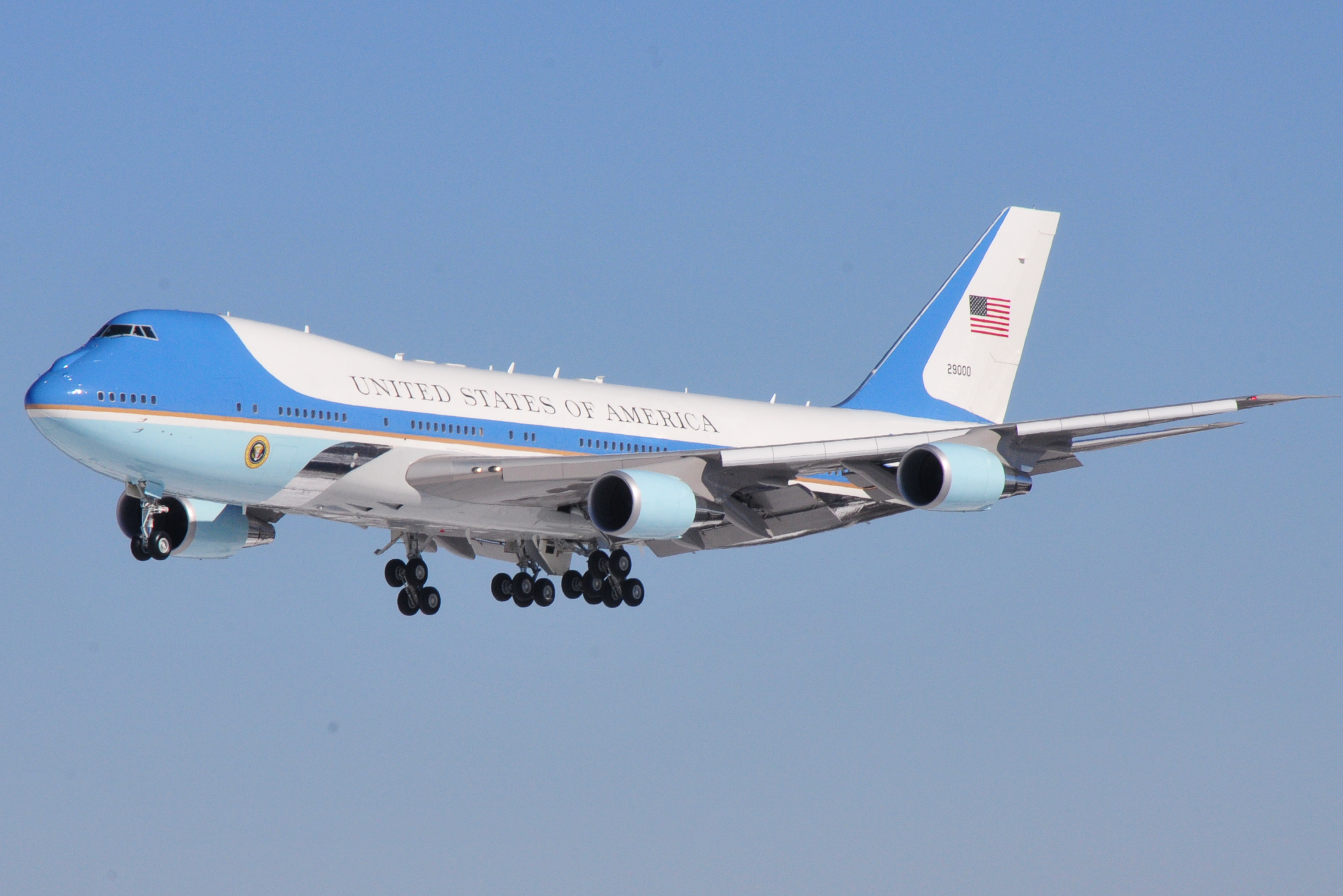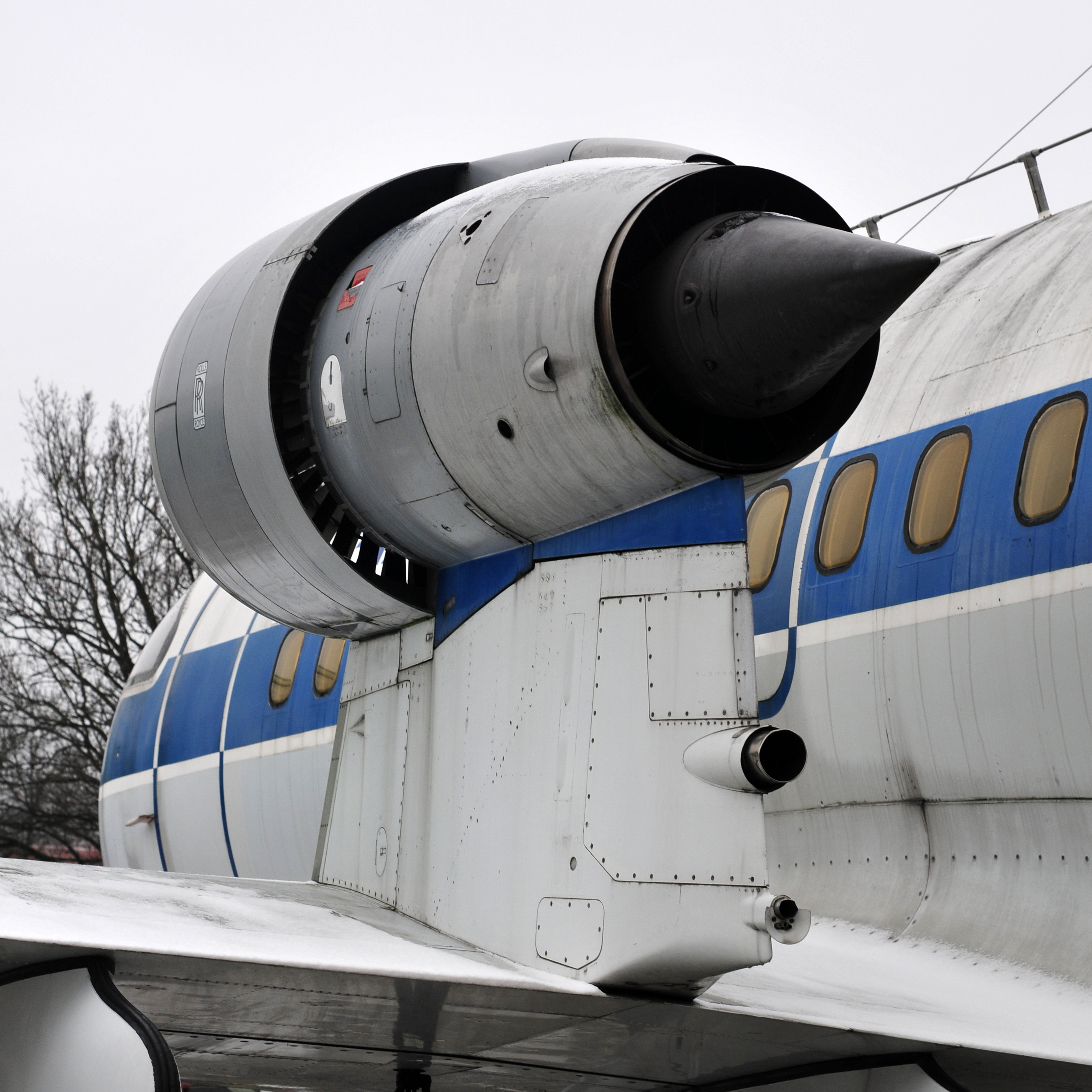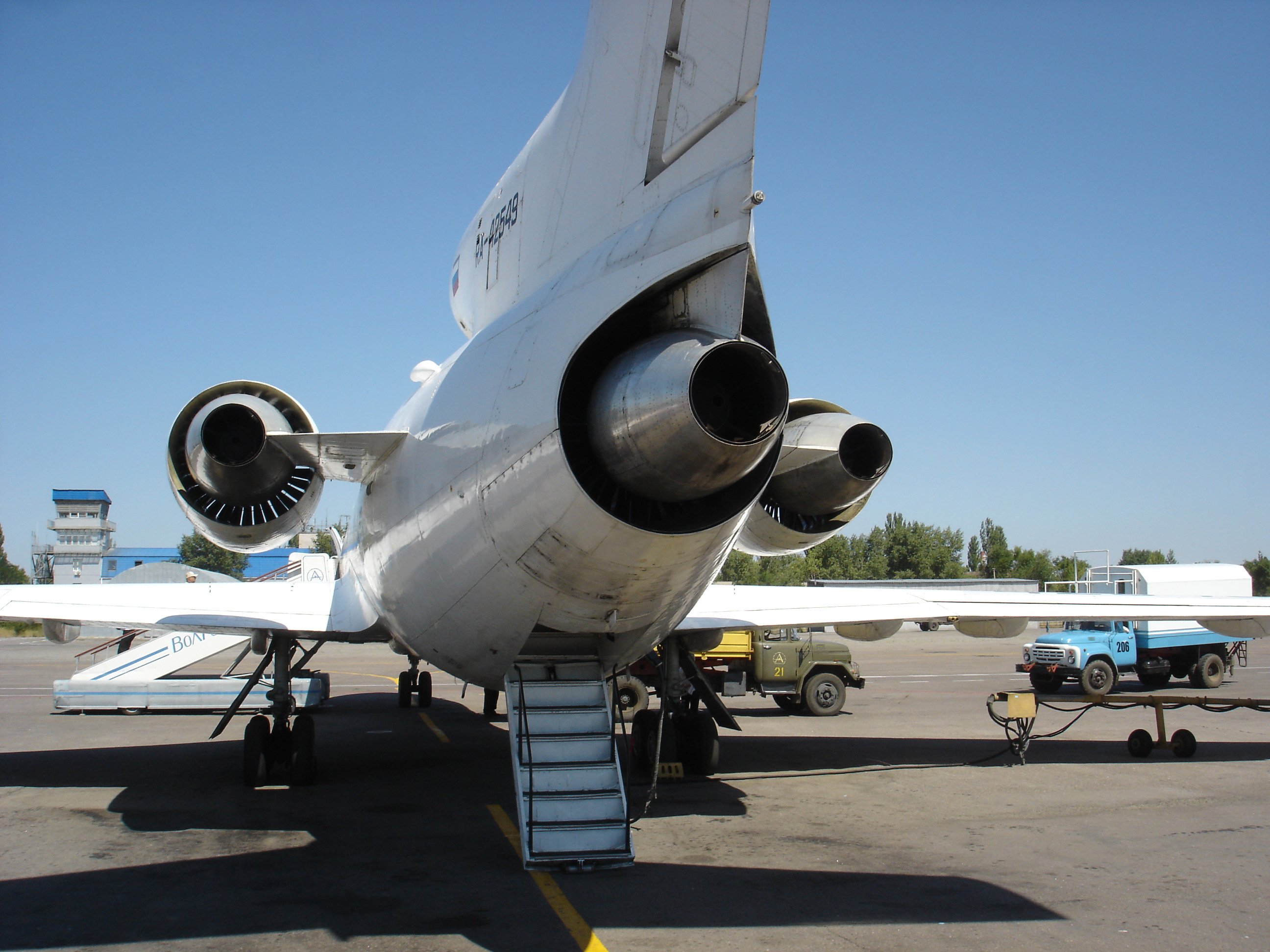|
Airstair
An airstair is a set of steps built into an aircraft so that passengers may board and alight the aircraft. The stairs are often built into a clamshell-style door on the aircraft. Airstairs eliminate the need for passengers to use a mobile stairway or jetway to board or exit the aircraft, providing more independence from ground services. Some of the earliest aircraft to feature airstairs were the Martin 2-0-2 and Martin 4-0-4. Some models of the Douglas DC-3 were also retrofitted with airstairs. As airport infrastructure has developed, the need for airstairs has decreased, as jetways or mobile stairways are often available. Wide-body aircraft rarely employ airstairs, as the doors are significantly higher above the ground than narrow-body aircraft. One notable exception is the Lockheed L-1011, the only wide-body aircraft to feature full-height airstairs. The only other wide-bodies with airstairs, the VC-25 and the Ilyushin Il-86, have airstairs contained in the cargo hold, w ... [...More Info...] [...Related Items...] OR: [Wikipedia] [Google] [Baidu] |
McDonnell Douglas DC-9
The McDonnell Douglas DC-9 is an American five-abreast single-aisle aircraft designed by the Douglas Aircraft Company. It was initially produced by the developer company as the Douglas DC-9 until August 1967 and then by McDonnell Douglas. After introducing its heavy DC-8 in 1959, Douglas approved the smaller, all-new DC-9 for shorter flights on April 8, 1963. The DC-9-10 first flew on February 25, 1965, and gained its type certificate on November 23, to enter service with Delta Air Lines on December 8. The aircraft has two rear-mounted Pratt & Whitney JT8D low-bypass turbofans under a T-tail for a cleaner wing aerodynamic, a two-person flight deck and built-in airstairs. The Series 10 are 104 ft (32 m) long for typically 90 coach seats. The Series 30, stretched by 15 ft (4.5 m) to seat 115 in economy, has a larger wing and more powerful engines for a higher maximum takeoff weight ( MTOW); it first flew in August 1966 and entered service in February 1967. The Ser ... [...More Info...] [...Related Items...] OR: [Wikipedia] [Google] [Baidu] |
McDonnell Douglas MD-80
The McDonnell Douglas MD-80 is a series of five-abreast single-aisle airliners developed by McDonnell Douglas. It was produced by the developer company until August 1997 and then by Boeing Commercial Airplanes. The MD-80 was the second generation of the DC-9 family, originally designated as the DC-9-80 (DC-9 Series 80) and later stylized as the DC-9 Super 80 (short ''Super 80''). Stretched, enlarged wing and powered by higher bypass Pratt & Whitney JT8D-200 engines, the aircraft program was launched in October 1977. The MD-80 made its first flight on October 18, 1979 as the Super 80 and was certified on August 25, 1980. The first airliner was delivered to launch customer Swissair on September 13, 1980, which introduced it into commercial service on October 10, 1980. Keeping the fuselage cross-section, longer variants are stretched by 14 ft (4.3 m) from the DC-9-50 and have a 28% larger wing. The larger variants (MD-81/82/83/88) are 148 ft (45.1 m) long to sea ... [...More Info...] [...Related Items...] OR: [Wikipedia] [Google] [Baidu] |
737 Combi
737 most commonly refers to: * Boeing 737, an American narrow-body passenger airplane ** Boeing 737 Classic ** Boeing 737 MAX ** Boeing 737 Next Generation * AD 737, a year in the common era * 737 BC, a year * 737 (number), a number 737 may also refer to: Arts, entertainment, and media Literature * Minuscule 737, a Greek minuscule manuscript Television * '' Pinoy Big Brother: 737'', a twelfth season of ''Pinoy Big Brother'' * "Seven Thirty-Seven", a season 2 episode of ''Breaking Bad'' Places * 737 area code, a telephone area code in Austin, Texas, United States * 737 Park Avenue, a residential building in New York City, New York, United States * 737 Vancouver Street, a Victorian-style home in Victoria, British Columbia, Canada Military * 737 Naval Air Squadron, a Royal Navy helicopter squadron * 737th Expeditionary Airlift Squadron, a provisional United States Air Force unit * ''USS Kentucky'' (SSBN-737), an ''Ohio''-class ballistic missile submarine Science and techno ... [...More Info...] [...Related Items...] OR: [Wikipedia] [Google] [Baidu] |
Airbus A320
The Airbus A320 family is a series of narrow-body airliners developed and produced by Airbus. The A320 was launched in March 1984, first flew on 22 February 1987, and was introduced in April 1988 by Air France. The first member of the family was followed by the longer A321 (first delivered in January 1994), the shorter A319 (April 1996), and the even shorter A318 (July 2003). Final assembly takes place in Toulouse in France; Hamburg in Germany; Tianjin in China since 2009; and in Mobile, Alabama in the United States since April 2016. The twinjet has a six-abreast cross-section and is powered by either CFM56 or IAE V2500 turbofans, except the CFM56/PW6000 powered A318. The family pioneered the use of digital fly-by-wire and side-stick flight controls in airliners. Variants offer maximum take-off weights from , to cover a range. The 31.4 m (103 ft) long A318 typically accommodates 107 to 132 passengers. The 124-156 seat A319 is 33.8 m (111 ft) long. ... [...More Info...] [...Related Items...] OR: [Wikipedia] [Google] [Baidu] |
Boeing 737
The Boeing 737 is a narrow-body aircraft produced by Boeing at its Boeing Renton Factory, Renton Factory in Washington (state), Washington. Developed to supplement the Boeing 727 on short and thin routes, the twinjet retains the Boeing 707, 707 fuselage width and six abreast seating with two underwing turbofans. Envisioned in 1964, the initial 737-100 made its first flight in April 1967 and entered service in February 1968 with Lufthansa. The lengthened 737-200 entered service in April 1968, and evolved through four generations, offering several variants for 85 to 215 passengers. The 737-100/200 original variants were powered by Pratt & Whitney JT8D low-bypass engines and offered seating for 85 to 130 passengers. Launched in 1980 and introduced in 1984, the Boeing 737 Classic, 737 Classic -300/400/500 variants were re-engine, upgraded with CFM International CFM56#CFM56-3B-1, CFM56-3 turbofans and offered 110 to 168 seats. Introduced in 1997, the Boeing 737 Next Generation, 7 ... [...More Info...] [...Related Items...] OR: [Wikipedia] [Google] [Baidu] |
Boeing VC-25
The Boeing VC-25 is a military version of the Boeing 747 airliner, modified for presidential transport and commonly operated by the United States Air Force (USAF) as ''Air Force One'', the call sign of any U.S. Air Force aircraft carrying the president of the United States. Only two examples of this aircraft type are in service; they are highly modified Boeing 747-200Bs, designated VC-25A and having tail numbers 28000 and 29000. Although technically the ''Air Force One'' designation applies to the aircraft only while the president is on board, the term is commonly used to refer to the VC-25 in general. The two aircraft often operate in conjunction with ''Marine One'' helicopters, which ferry the president to airports whenever a vehicle motorcade would be inappropriate. Two new aircraft, designated VC-25B and based on the Boeing 747-8, have been ordered by the USAF to replace the aging VC-25As. Development By 1985, the pair of Boeing 707-based VC-137s used as the presidential ... [...More Info...] [...Related Items...] OR: [Wikipedia] [Google] [Baidu] |
VFW-Fokker 614
The VFW-Fokker 614 (also VFW 614) was a twin-engined jetliner designed and constructed by West German aviation company VFW-Fokker. It is the first jet-powered passenger liner to be developed and produced in West Germany (the East German Baade 152 being the first German jet airliner), as well as the first German-built civil aircraft to have been manufactured for a decade.Mendenhall 2005, p. 326. The VFW 614 was originally proposed during the early 1960s as the E.614, which was a concept for a 36–40 seat aircraft by a consortium of West German aircraft companies, who were soon re-organised into Vereinigte Flugtechnische Werke (VFW). Originally intended as a Douglas DC-3 replacement, its most distinctive feature was that its engines were mounted in pods on pylons above the wing. The VFW 614 was produced in small numbers during the early- to mid-1970s by VFW-Fokker, a company resulting from a merger between VFW and the Dutch aircraft company Fokker. The program was cancelled in 19 ... [...More Info...] [...Related Items...] OR: [Wikipedia] [Google] [Baidu] |
Fokker F-28
The Fokker F28 Fellowship is a twin-engined, short-range jet airliner designed and built by Dutch aircraft manufacturer Fokker. Following the Fokker F27 Friendship, an early and commercially successful turboprop-powered regional airliner, Fokker decided to embark on developing a new turbojet-powered commuter aircraft that would build upon its experiences with the F27. During the design phase, a high level of attention was paid to market research and operator concerns; amongst other changes made, the prospective jetliner was increased in size, changing its maximum seating capacity from 50 to 65 passengers. During April 1962, Fokker announced the formal launch of the F28 Fellowship. On 9 May 1967, the prototype F28-1000 conducted its maiden flight. Type certification was achieved on 24 February 1969, and the first revenue-earning flight by Braathens was performed on 28 March 1969. Following its entry to service, Fokker developed multiple variants of the F28; one model, the F28-2000 ... [...More Info...] [...Related Items...] OR: [Wikipedia] [Google] [Baidu] |
Yakovlev Yak-42
The Yakovlev Yak-42 (russian: Яковлев Як-42; NATO reporting name: "Clobber") is a 100/120-seat three-engined mid-range passenger jet developed in the mid 1970s to replace the technically obsolete Tupolev Tu-134. It was the first airliner produced in the Soviet Union to be powered by modern high-bypass turbofan engines.Gunston, 1997 Development In 1972, the Yakovlev design bureau started work on a short- to medium-range airliner capable of carrying 100–120 passengers. It was intended to be a replacement for the Tupolev Tu-134 jet as well as the Ilyushin Il-18, Antonov An-24 and An-26 turboprop airliners. While the new airliner was required to operate out of relatively small airfields while maintaining good economy, as many Soviet airports had been upgraded to accommodate more advanced aircraft, it did not have to have the same ability to operate from grass strips as Yakovlev's smaller Yak-40. The requirement resulted in the largest, heaviest and most powerful aircr ... [...More Info...] [...Related Items...] OR: [Wikipedia] [Google] [Baidu] |
Yakovlev Yak-40
The Yakovlev Yak-40 (russian: Яковлев Як-40; NATO reporting name: Codling) is a regional jet designed by Yakovlev. The trijet's maiden flight was in 1966, and it was in production from 1967 to 1981. Introduced in September 1968, the Yak-40 has been exported since 1970. Development By the early 1960s, Soviet international and internal trunk routes were served by Aeroflot, the state airline, using jet or turboprop powered airliners, but their local services, many of which operated from grass airfields, were served by obsolete piston-engine aircraft such as the Ilyushin Il-12, Il-14 and Lisunov Li-2.Stroud 1968, p. 269–270. Aeroflot wanted to replace these elderly airliners with a turbine-powered aircraft, with the Yakovlev design bureau being assigned to design it. High speed was not required, but it would have to be able to operate safely and reliably out of poorly equipped airports with short (less than 700 m or 2,300 ft) unpaved runways in poor weather.Gun ... [...More Info...] [...Related Items...] OR: [Wikipedia] [Google] [Baidu] |


.jpg)
.jpg)





_Tulpar_Air).jpg)